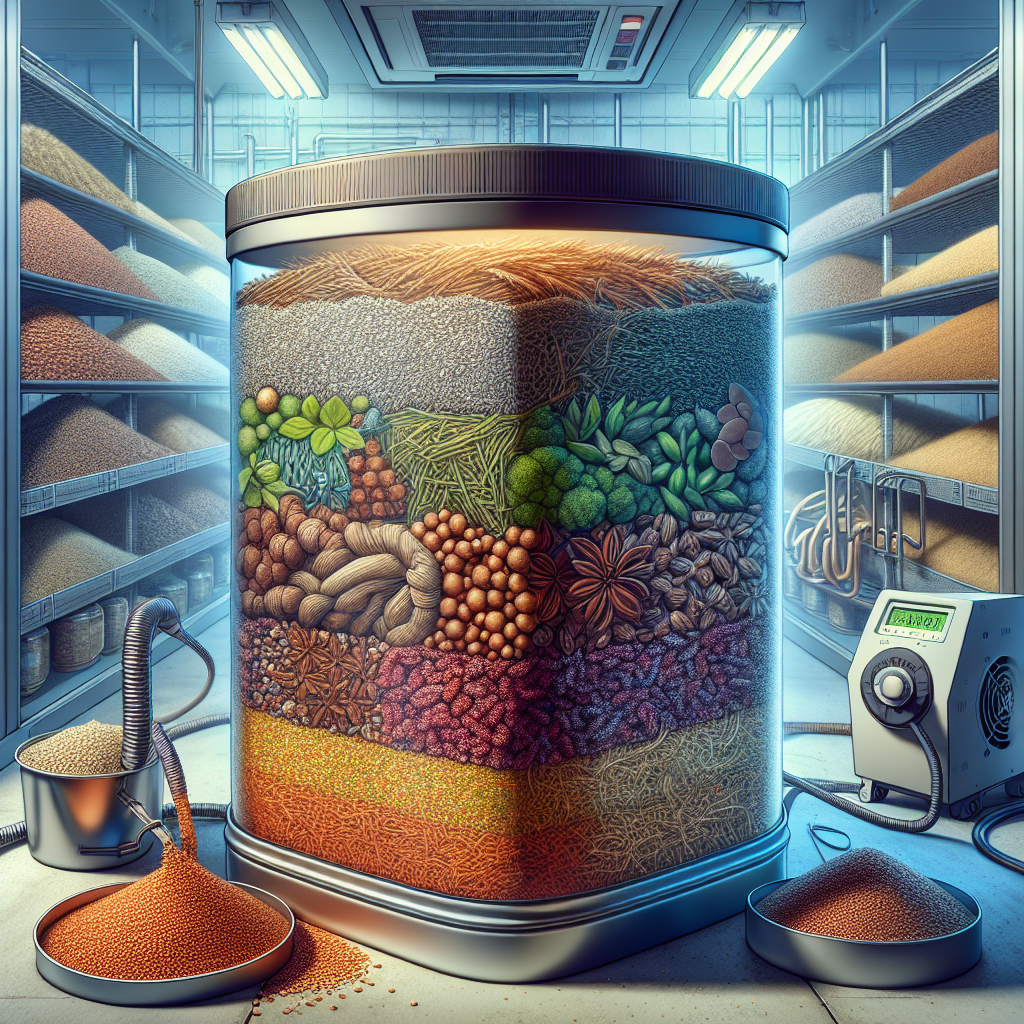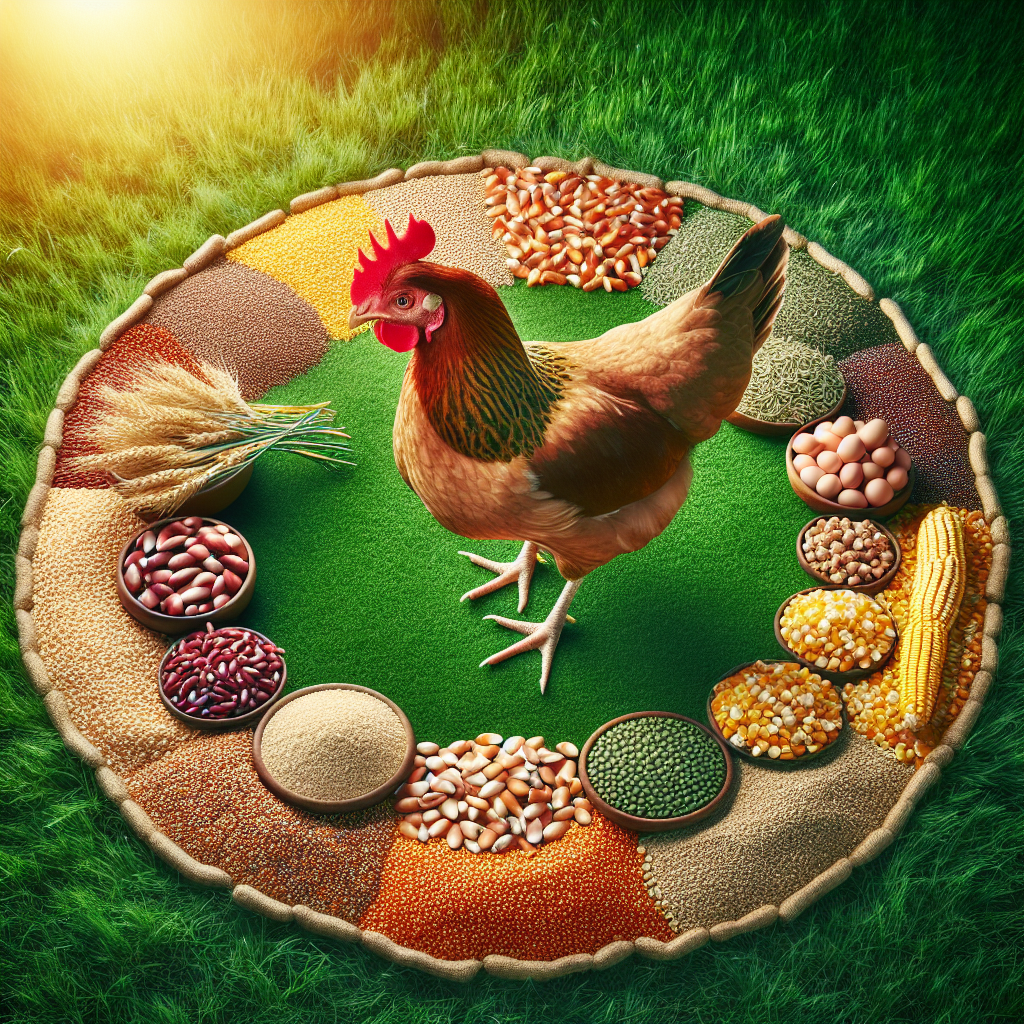If you’re wondering how to maintain the nutritional quality of organic feeds, you’ve come to the right place! Storing organic feeds properly is essential in preserving their nutrients and ensuring your livestock receive all the goodness they need. In this article, we will guide you through some simple yet effective tips to help you store organic feeds in a way that keeps their nutritional value intact. So, let’s get started and ensure your animals get the best feed possible!
Proper Storage Conditions
When it comes to storing organic feeds, proper storage conditions play a vital role in maintaining their nutritional quality. Temperature, humidity, and light exposure are all factors that can greatly affect the quality and shelf life of organic feeds.
Temperature
The ideal temperature for storing organic feeds is between 50°F and 70°F (10°C and 21°C). Extreme heat or cold can lead to nutrient loss and spoilage, so it’s important to store the feeds in a temperature-controlled environment. Avoid storing the feeds near sources of heat or in areas that experience frequent temperature fluctuations.
Humidity
High humidity can cause organic feeds to become damp and promote the growth of mold and bacteria. To prevent this, it is essential to store the feeds in a dry environment with humidity levels below 15%. Using dehumidifiers or moisture-absorbing products can help maintain the desired humidity level and preserve the feeds’ nutritional value.
Light Exposure
Exposure to light, especially sunlight, can cause the breakdown of vitamins and essential nutrients in organic feeds. It is crucial to store them in a dark or low-light environment to minimize nutrient degradation. Opaque containers or packaging that block out light are highly recommended to protect the feeds from light exposure.
Packaging and Containers
The choice of packaging and containers can significantly impact the quality and freshness of organic feeds. It is essential to consider the following factors when selecting packaging and containers for storage:
Sealed Containers
Using sealed containers is crucial for preserving the nutritional quality of organic feeds. Airtight containers or bags prevent the entry of moisture, pests, and air that can lead to spoilage and nutrient loss. Ensure that the containers are properly sealed to maintain the feeds’ freshness and prevent contamination.
Opaque Packaging
Opt for opaque packaging to minimize light exposure. Light can break down essential nutrients, vitamins, and antioxidants in organic feeds. Opaque packaging materials, such as dark-colored bags or containers, help block out light and protect the feeds from nutrient degradation caused by light exposure.
Airtight Packaging
Airtight packaging is vital to prevent moisture, air, and pests from entering the containers. Airtight bags or containers create a barrier that maintains the feeds’ freshness and nutritional quality. It is recommended to choose packaging that can be tightly sealed and effectively keeps out external factors that can affect the feeds’ integrity.
Location
Where you choose to store organic feeds can greatly impact their nutritional quality and longevity. Here are some key considerations when selecting an appropriate storage location:
Dry and Clean Area
Select a storage area that is dry and clean to avoid moisture buildup and potential contamination. Moisture can lead to mold growth and spoilage of the feeds. Additionally, a clean storage area reduces the risk of pests and rodent infestation and prevents the introduction of harmful substances into the feeds.
Away from Chemicals
Organic feeds should be stored away from any chemicals or harmful substances that can contaminate them. Chemical exposure can alter the nutritional composition of the feeds and render them unsafe for consumption. Ensure that the storage area is free from any potential sources of contamination, such as pesticides, fertilizers, or cleaning agents.
Rodent-Free Area
Rodents can not only consume and contaminate organic feeds but also cause structural damage to the storage facility. Choosing a rodent-free area and implementing proper pest control measures minimize the risk of infestation and preserve the feeds’ quality. Regular inspections and sealing any potential entry points can help prevent rodent problems.
Avoiding Contamination
Maintaining the integrity of organic feeds and preventing contamination is crucial to preserve their nutritional quality. Here are some measures to consider for avoiding contamination:
Separation from Non-Organic Feeds
Store organic feeds separately from non-organic feeds to prevent cross-contamination. Mixing organic and non-organic feeds can compromise the organic status of the feeds and potentially introduce harmful substances into the organic feeds.
Preventing Pest Infestation
Pests, such as insects or rodents, can contaminate organic feeds and compromise their quality. Implementing adequate pest control measures, such as regular cleaning, sealing entry points, and using traps or baits, can help prevent pest infestation and safeguard the nutritional integrity of the feeds.
Proper Cleaning of Storage Area
Regularly clean the storage area to remove any dust, debris, or spilled feeds. Cleaning the storage area prevents the growth of molds, bacteria, and pests that can contaminate the organic feeds. Use appropriate cleaning products that are safe for organic feeds and follow proper cleaning protocols to ensure thorough cleanliness.
Regular Inspections
Regular inspections are essential to ensure the quality and freshness of organic feeds. By regularly assessing the feeds, you can identify any signs of spoilage and take appropriate action to maintain their nutritional value.
Checking for Signs of Spoilage
Inspect the organic feeds for any signs of spoilage, such as mold, foul odor, or abnormal discoloration. If any feeds exhibit these signs, discard them immediately to prevent consumption of spoiled or rancid feeds. Regular visual inspections help identify any feed that may have been damaged or compromised.
Monitoring Expiry Dates
Keep track of the expiry dates of the organic feeds to ensure they are consumed before they spoil. Consuming feeds past their expiration date may result in loss of nutritional value and potential risks to animal health. Proper inventory management and rotation can help ensure that older feeds are used before newer ones.
Quality Assurance
Maintain a system for quality assurance to monitor the overall quality of the organic feeds. This includes conducting periodic laboratory testing for nutrient levels and potential contaminants. Quality assurance measures help ensure that the feeds meet the required standards and maintain their nutritional integrity.
Organic Feed Rotation
Implementing a feed rotation system is crucial for ensuring that the oldest feeds are used first, minimizing the risk of spoilage and nutrient loss. Here are some methods to consider for effective feed rotation:
First-In, First-Out (FIFO) Method
Adopt the First-In, First-Out (FIFO) method to ensure that the oldest feeds are used before newer ones. This helps prevent feed deterioration and nutrient loss by prioritizing the consumption of older feeds. Proper labeling and inventory management are essential for implementing this rotation method effectively.
Monitoring Feed Usage
Regularly monitor feed usage to track the consumption rate and adjust inventory accordingly. Keeping track of feed usage helps prevent stockpiling and ensures that feeds are being used within their recommended shelf life. This helps maintain the nutritional quality of the feeds and avoids unnecessary waste.
Avoiding Stockpiling
It is generally advisable to avoid stockpiling large quantities of organic feeds, especially if storage conditions are not optimal. Stockpiling can increase the risk of spoilage, pest infestation, and nutrient degradation. Purchasing and storing feeds in smaller, manageable quantities helps ensure freshness and reduces the chances of waste.
Moisture Control
Proper moisture control is essential in preserving the nutritional quality of organic feeds. Excess moisture can lead to spoilage, mold growth, and nutrient loss. Here are some measures to consider for effective moisture control:
Using Desiccants
Desiccants are substances that aid in moisture control by absorbing excess moisture from the storage environment. Adding desiccants, such as silica gel packs, can help maintain the desired moisture level and prevent feed spoilage. Ensure that the desiccants used are safe for organic feeds and follow recommended usage guidelines.
Avoiding Condensation
Condensation can occur when there is a significant difference in temperature between the feeds and the surrounding environment. To avoid condensation, it’s crucial to store organic feeds in a controlled environment with consistent temperature and humidity levels. Minimizing temperature fluctuations and moisture buildup helps preserve the feeds’ nutritional quality.
Monitoring Feed Moisture
Regularly monitor the moisture levels of organic feeds to ensure they remain within the recommended range. Moisture meters or similar tools can help determine if the feeds are too damp and require intervention. Proper moisture control helps prevent spoilage and the growth of molds or bacteria, ensuring the feeds’ nutritional integrity.
Storage Periods
Different organic feeds have varying recommended storage periods. It’s important to consider the following guidelines for short-term and long-term storage:
Short-Term Storage Recommendations
For short-term storage, typically up to several months, ensure that the feeds are stored in appropriate conditions (temperature, humidity, and light) as mentioned earlier. Regular inspections, proper packaging, and feed rotation should be maintained to ensure freshness and nutritional quality during this period.
Long-Term Storage Recommendations
For long-term storage, typically exceeding several months, additional considerations come into play. Vacuum-sealed packaging, freezing, or using oxygen absorbers can help extend the shelf life of organic feeds. However, it is important to consult the feed manufacturer or supplier for specific recommendations on long-term storage of the particular feeds.
Proper Handling
Proper handling of organic feeds is vital to maintain their nutritional quality and prevent contamination. Here are some guidelines to follow for proper handling:
Avoid Rough Handling
Organic feeds should be handled with care to minimize physical damage and nutrient loss. Rough handling, such as dropping or tossing bags, can lead to compromised feeds and potential nutrient degradation. Handle the feeds gently to ensure their integrity and nutritional value.
Minimal Exposure to Air
Exposure to air can lead to oxidation and nutrient loss in organic feeds. When handling the feeds, minimize their exposure to air by promptly sealing bags or containers after use. This helps preserve their freshness and nutritional quality.
Preventing Cross-Contamination
To prevent cross-contamination, avoid using the same tools or equipment for different feeds. Clean and sanitize any utensils, scoops, or containers before handling a new batch of feeds. Preventing cross-contamination helps maintain the purity and organic status of the feeds.
Supplier Guidelines
Following the guidelines provided by the feed manufacturer or supplier is crucial to ensure proper storage and maintenance of organic feeds. Here are some key considerations:
Following Manufacturer Recommendations
Read and follow the specific storage recommendations provided by the feed manufacturer or supplier. Different feeds may have unique requirements based on their composition and processing methods. Adhering to these guidelines helps ensure optimal storage conditions and maintains the nutritional quality of the feeds.
Consulting with Feed Suppliers
If you have any questions or concerns regarding the storage of organic feeds, it is best to consult with your feed supplier or manufacturer. They can provide valuable insights and recommendations based on their expertise and knowledge of the specific feeds you are using. Establishing a good line of communication with your supplier is essential for maintaining the quality of your organic feeds.
Education and Training
Continuous education and training on proper storage practices for organic feeds are essential for maintaining their nutritional quality. Stay updated on the latest guidelines and best practices through industry resources, workshops, or seminars. By staying informed, you can ensure that you are implementing the most effective storage methods and preserving the nutritional integrity of your organic feeds.




